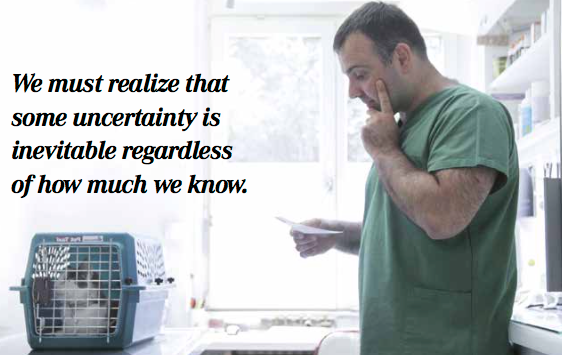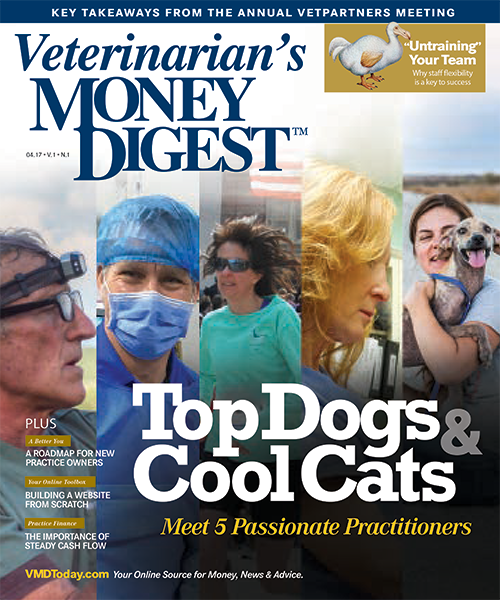The Psychological Impact of Uncertainty: Why a Bigger IQ Isn't the Answer
Emotional insecurity in practice is inevitable, but it can be managed.

When I'm coaching veterinarians in exam room skills, I’ve noticed a pattern whereby confidence dips about three years after graduation. I hear comments such as “I honestly thought I’d feel more in control by now” or “I feel less confident now than the day I graduated.” I call this the “three-year wobble.”
In the first year after graduation, we know we have much to learn and expect to come across situations about which we have no previous experience and little practical knowledge. We accept this inevitable period of living with the unknown during this stage of our career, and we’re prepared to ask for help and accept direction. In the second year, as we continue to learn, we are still comfortable seeking help and receiving direction.
Toward the end of the second, third and even fourth years in practice, many veterinarians start feeling like they “should have this by now.” That is, they should be able to diagnose what is wrong with most patients after taking a history and performing a clinical exam.
Doubt Is Inevitable
Doubt in certain situations in veterinary practice is inevitable. The problem for many of us is that two misconceptions turn this situational doubt into self-doubt.
Misconception #1: If I Know More, I Will Stop Feeling Doubtful.
Many veterinarians believe that the antidote to their feelings of doubt is to acquire more knowledge. Of course, during the first couple years in practice, it is important to develop our knowledge and skills related to the pathogenesis, diagnosis and therapeutics associated with specific diseases. It is our IQ that gives us the psychological horsepower required to do this. However, understanding and remembering this information only takes us so far in managing the inevitable feelings of uncertainty that we experience in practice.
Misconception #2: Maybe I’m Not Good/ Smart/Talented Enough!
Having tried unsuccessfully to escape the fog of uncertainty by working through the first misconception, our minds start looking for an alternative explanation for our persistent feelings of doubt. And so, the second misconception that starts to form in many veterinarians’ minds at this three-year mark is, “I’ve tried extra hard to learn this stuff, but I’m still not sure. Maybe I’m not good, smart or talented enough to be a veterinarian!”
Living under this assumption will have a negative impact on career fulfillment, on success and on our lives in general. This “happiness-limiting belief” serves as a seed for feelings of inferiority, emotional insecurity, and diminished ambitions and aspirations. If allowed to fester, such feelings can lead to helplessness, hopelessness and even depression.
Coping With Uncertainty
To achieve the psychological security we crave, we need to work on two things: One, our ability to cope with uncertainty and two, our “self-theories.” Self-theories are beyond the scope of this article. Here we focus on the theory and practice of coping with uncertainty.
Once we take a history and perform a clinical exam, we often cannot be exactly sure about what is causing that cough, sneeze, vomiting, limp or scratch based on what we see, hear, feel and smell. After all, few clinical signs are pathognomonic of only one diagnosis. This means that we will almost always feel at least some degree of uncertainty during most veterinary visits. Instead of thinking that more knowledge is the antidote, we must realize that some uncertainty is inevitable regardless of how much we know.
That doesn’t mean it should overwhelm us, though. The good news is that a relatively small investment of time and effort spent recognizing and working on a different set of psychological skills and abilities can help us relieve more stress over a career than tenfold the time and effort spent working on filling relatively small knowledge gaps.

Thriving amid uncertainty requires a different set of psychological skills and abilities than IQ. I call this capacity “UQ” — the ability to be intelligent with and about uncertainty. Because life is inevitably uncertain, we all need UQ to prevent us from becoming paralyzed by indecision.
While our IQ helps us acquire and remember the conceptual models needed to understand an animal’s various biological systems, our UQ helps us manage the uncertainty and doubt associated with determining what disrupts these systems and the probabilities that our interventions will correct these disruptions.
Combining IQ with UQ enables us to work amid uncertainty and risk. By developing our UQ we become more resilient in the face of uncertainty, which is the first step in preventing situational doubt from turning into self-doubt. Here’s a look at how we apply these concepts in practice.
Managing Uncertainty: The PDS Link
P Is for Problems
It is important to articulate to the client clearly and succinctly the “problems” discovered during the office visit. Remembering, ranking and repeating the historical and physical findings inspires confidence in the client’s mind and provides a launchpad from which to discuss the options available to resolve them.
D Is for Differentials
Clients expect you to give them plausible explanations about what is — or could be — causing their pet’s signs. This is the D step of the PDS link. Although much thought may go into formulating your differentials list, as far as the client is concerned the D step should result in a list of the three or four most likely causes of the signs. Articulating a short and succinct differentials list acknowledges to the client in a controlled and assertive way the inherent uncertainty of the situation. Not being 100 percent sure of your diagnosis is nothing to be ashamed of as long as you show that you “have a clue” about what is going on and that you have a way of dealing with this uncertainty.
S Is for Strategies
There are ultimately only three strategies available to resolve the clinical signs presented during an office visit: the reactive strategy, the proactive strategy and euthanasia.
- Reactive strategy: The premise of the reactive strategy is to treat based on a presumptive diagnosis and then “react” according to how the patient responds. The risk with this strategy relates to picking the wrong diagnosis, which affects both clinical resolution and client satisfaction.
- Proactive strategy: This strategy aims to manage the uncertainty about what is causing the signs and/or to treat them more precisely. The ideal of the proactive strategy is to make and treat a 100 percent conclusive diagnosis using a gold-standard evidence-based intervention, although this is not always possible for both technical and practical reasons. It is useful to think of proactive diagnostics in terms of “buying information” to decrease the probability of treating (or euthanizing) the patient for the wrong condition. Of course, recommending a rash of diagnostic tests just because they are available without a clear plan about what information will be gained in relation to the differential diagnosis is speculative, unfocused and often wasteful.
Conclusion
Uncertainty occurs when the cause and the consequences of events are undetermined — and veterinary work is certainly full of uncertainty. To achieve both professional and personal success, we must be aware of the impact of uncertainty on our feelings of stress, self-doubt and self-confidence and understand the best ways to manage it.
Dr. Faulkner currently divides his time between working in his own small animal practice in Suffolk, England, and coaching practice owners and managers. His consulting business, The Colourful Consultation, helps veterinarians proactively pursue the four essential outcomes of veterinary practice: clinical resolution, client satisfaction, financial resolution and colleague satisfaction. For more information, visit colourfulconsultation.com.

UN, WHO address public health concern over avian flu transmission to humans
April 18th 2024Veterinary professionals working with certain animals are advised to take precautionary steps to minimize risk of infection, while researchers in Texas study potential H5N1 vaccines, antivirals, and antibody therapies for humans
Read More